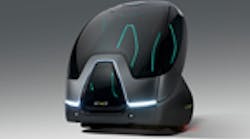GM EN-V Concept car
GM EN-V Concept car
GM EN-V Concept car
GM EN-V Concept car
GM EN-V Concept car
GM EN-V Concept car
General Motors (GM) and SAIC Motors showed off a number of their 2-wheeled EN-V concept car at the World Expo 2010 Shanghai. It balances itself like a Segway allowing for tight maneuvers. It is designed to provide transportation in an ubran setting for one or two people. The electric vehicles are compact and energy efficient. As it turns out, balancing does not take as much energy as you might think. The small turning radius and size are ideal for tight quarters.
The EN-V is based on the Personal Urban Mobility and Accessibility (PUMA) technology developed by Segway. Segway and GM collaborated on the drivetrain. It uses the same technology as the Segway Human Transporter. The big difference is that it balances the vehicle by moving the battery pack that is on a sliding frame. The Human Transporter shifted the weight by manipulating the wheels alone.
The resulting system is about one third that of a conventional vehicle. The EN-V weighs in around 500 kg and is about 1.5m long. It has a top speed of 40 km/h (25 mph) and a 40 km (25 mile) range. The plastic body employs carbon fibers for strength.
The system is very similar to the Segway in that it is a drive-by-wire system. The EN-V can also operate in autonomous mode in conjunction with GPS support and vehicle-to-vehicle communication. In theory, multiple units could play follow the leader to provide support for more people. The motors provide drive as well as braking. The EN-V runs off lithium ion batteries. The charger plugs into a normal outlet. Unlike the Segway, mounting the EN-V is from the front and in unpowered mode the EN-V simply leans forward providing a stable 3-point platform.The demo units have a small storage space behind the seats.
These are concept cars so there a features that would be applicable to other platforms as well. For example, EN-V has proximity sensors allowing it to detect obstacles and pedestrians so the vehicle can slow down or stop if something moves in front of the vehicle. It also helps with features such as lane departure warning, blind zone detection and adaptive cruise control that are available today.
GM is taking the long term, 20-year view of the EN-V so it is likely to evolve over the years. I suspect that a few of us would like to try one out right now.


